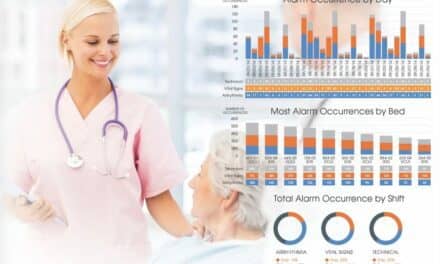By Arleen Thukral, MS, CCE, CHTM
Fast Healthcare Interoperability Resources (FHIR, pronounced “fire”) is a draft standard that Health Level Seven International (HL7) published in February 2014—and it’s attractive because it’s based on a truly modern web services approach. Because FHIR is implemented on top of HL7 and the Hyper Text Transfer Protocol Secure (HTTPS) protocol, messages can be parsed by wire data analytics platforms for real-time data gathering. This liberates the document-centric approach to healthcare data by directly exposing discrete data elements as services.
Case in point: Healthcare elements, such as patients, admissions, diagnostic reports and medications, can be retrieved and manipulated via their own resource URLs. This information can then be streamed to a data store, where it easily correlates with other informatics data.
FHIR has also standardized the use of well-known security and log-on standards, such as OpenID Connect in the health records environment, thus preventing each project from having to reinvent this layer. Further, the vision for FHIR is similar to iOS and Android: to support a marketplace model for plug-and-play healthcare applications. And it’s popular, indeed; stakeholders from across the health IT ecosystem are actively exploring, experimenting, and testing FHIR. Potential use cases are endless and include tracking epidemics, warning users about adverse drug interactions, and displaying emergency room wait times.
Facilitating Decision Support
A key benefit of computerized structured medical records is the ability to provide automated expert input to the workflow. Specifically, FHIR has support for common decision support interactions between separate systems and can share the necessary analysis data in a standard format. One example is Intermountain Healthcare’s Pediatric Growth Chart on the FHIR app developed by Boston Children’s Hospital. This app displays children’s heights, weights, and head circumferences, extracted from electronic medical records (EMRs) using FHIR resources, against pertinent growth curves to compare their growth to their peers.
Sharing Key Documents
Sharing medical documents such as test results, clinic letters, and imaging scans can dramatically improve patient outcomes and streamline care. With the status quo, if a physician requests just one piece of patient information, the system will often transfer multiple documents to fulfill the request. But this process is often inefficient since physicians may have to search through many pages of information to find one data element.
FHIR, on the other hand, makes it simple for someone to receive only the piece of information requested. It’s a fundamental shift from a document-centric approach to a data-level-access approach using application programming interfaces, or APIs.
Specifically, FHIR features a concept called “Resources,” meaning very basic sets of structured data. Today’s standard coding sets—such as Logical Observation Identifiers Names and Codes, or LOINC—allow exchange for lab results or RXNorm—the U.S. National Library of Medicine’s Unified Medical Language System—for medications. Further, FHIR offers developers tools to collect and present much smaller data elements, thus enhancing the context and meaning of the information.
To meet this need, the CommonWell Alliance formed at the 2013 HIMSS conference to bring together EHR vendors and other partners to develop and deploy technical standards, such as FHIR, to ease the process of sharing data and exchanging health information on a provider-to-provider level. CommonWell presently encompasses more than 60 million patient health records and 80 different health IT company participants.
Services available include patient access privacy and consent management, record locator and retrieval, patient identification, and linking and data query (“Trusted Data Access”). Moreover, CommonWell has created a functioning record locator service, which allows providers to find all records associated with a patient—no matter where the care is delivered—thus solving conventional identify problems.
As of March 2018, more than 8,000 provider sites in all 50 states, as well as Washington, D.C. and Puerto Rico have gone live with CommonWell and have generated more than 115 million queries against the services. Athena Health, Cerner, McKesson, Evident, Greenway Health, OneRecord, and eClinicalWorks are some of the big names that have deployed CommonWell services in recent months.
Providers have noted that this exchange increases ease of access to patient records from previous medical encounters and provides a foundation to help improve the delivery of patient care. Further, the connection has enabled new medications and alerts to seamlessly integrate into the EHR, providing the most accurate and up-to-date information possible. It’s a significant milestone on the path to achieving true nationwide health IT interoperability.
Making It Personal
The rise of patient empowerment has led to more patients wanting access to their health records. FHIR is the first healthcare exchange standard designed as a mobile-friendly tool set of Representational State Transfer, or REST, and JavaScript Object Notation. FHIR allows developers to create new apps by using the public APIs. Not surprisingly, last January Apple announced that users could view their FHIR-compliant medical records on its iPhone Health App if their health providers made such data available. Major institutions including Johns Hopkins Medicine, Cedars-Sinai Medical Center, and Penn Medicine all participated in the launch.
Personally, I’m excited to see the future growth of FHIR, given the draft standard’s open and extensible nature. Still, barriers to implementation certainly exist—namely the challenge of overcoming the status quo. If the Office of the National Coordinator for Health Information Technology establishes and maintains a set of public API standards, for instance, EHR vendors will be required to use those public APIs to obtain certification. Ensuring that data is virtually “attached” to patients so that it is accessible at all times will enable better patient outcomes. Hoarding data in silos must come to an end.
Arleen Thukral, MS, CCE, is a VISN 20 biomedical engineer at VA NorthWest Healthcare Network in Seattle. Questions and comments can be directed to [email protected].
References:
- https://www.commonwellalliance.org/wp-content/uploads/2018/03/CommonWell-FactSheet-Services-March2018.pdf
- https://www.commonwellalliance.org/wp-content/uploads/2018/03/CommonWell-FactSheet-Providers-March2018.pdf
- https://www.apple.com/newsroom/2018/01/apple-announces-effortless-solution-bringing-health-records-to-iPhone/



